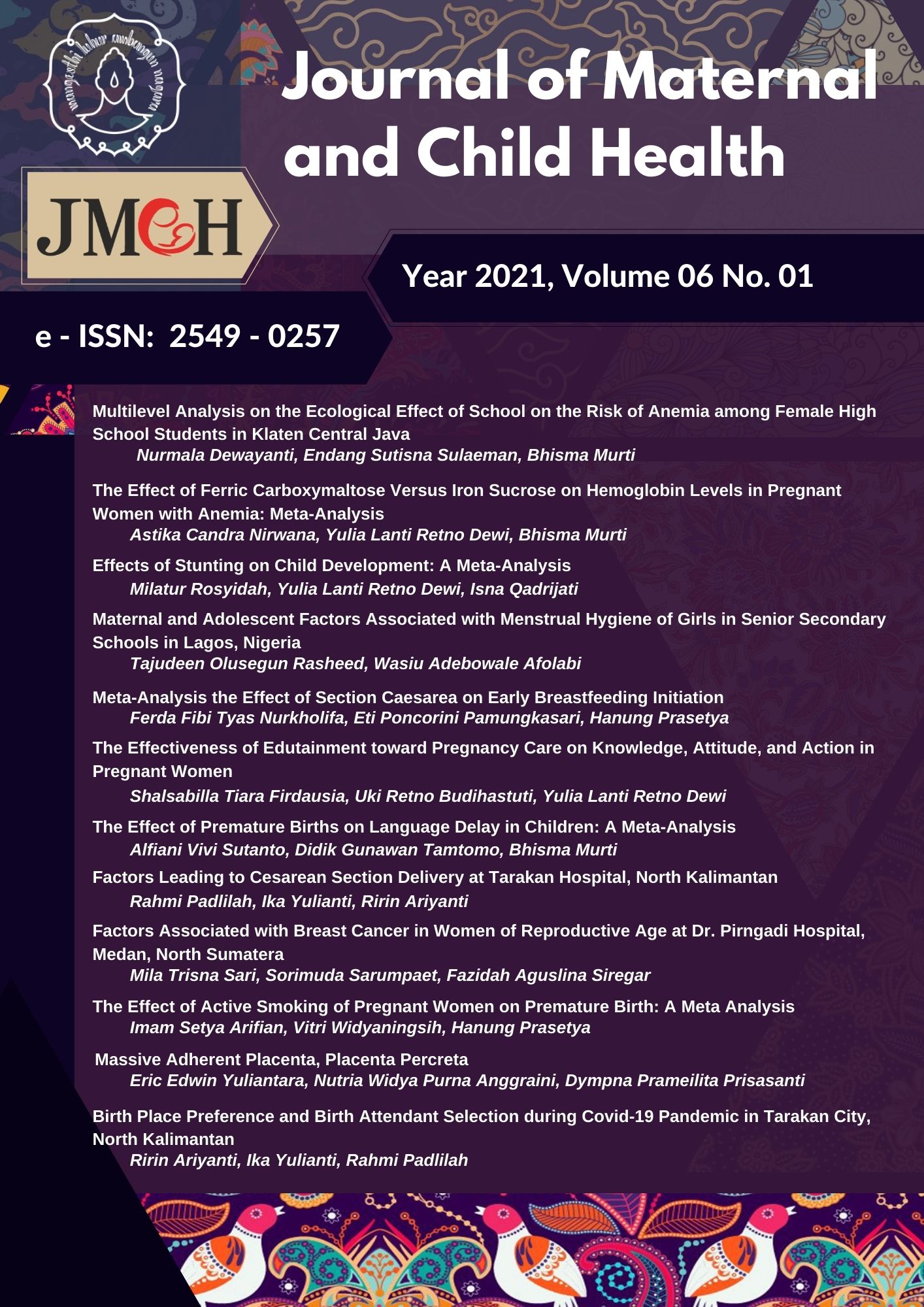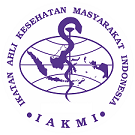Multilevel Analysis on the Ecological Effect of School on the Risk of Anemia among Female High School Students in Klaten Central Java
Abstract
Background: Anemia is a major nutritional problem worldwide. In 2018, at least 1.62 billion people were affected by anemia, and 33% were school children. Anemia in female ado
References
Ahmed AA, Yousef YE, Thabet AM, Alza-hrain AE (2018). Impact of educatio-nal program on theimprovement of anemia due to menstrual disorder in adolescent girls. IOSR-JNHS, 7(3): 60-66, https://doi:10.9790/1959-070-3016066
Ahwal S (2016). A study to assess the knowledge and prevalence of iron deficiency anemia among adolescent girls in a selected college of New Delhi. J Nurs Sci Pract. 6(3): 57-60. http://www.stmjournals.com/index.php?journal=JoNSP&page=article&op=view&path%5B%5D=7239.
Aprianti R, Sari GM, Kusumaningrum T (2018). Factors correlated with the intention of iron tablet consumption among female adolescents. Journal Ners, 13(1). http://dx.doi.org/10.20473/jn.v13i1.8368.
Badan Penelitian dan Pengembangan Kesehatan Departemen Kesehatan RI (2013). Riset Kesehatan Dasar (Basic Health Research). Jakarta
Briawan D (2013). Anemia masalah gizi pada remaja wanita (Anemia of nutritional problems in young women). Jakarta: EGC.
Chalise B, Aryal KK, Mehta RK, Dhimal M, Sapkota F, Mehata S, Karki KB, et al. (2018). Prevalence and correlates of anemia among adolescents in Nepal: Findings from a nationally representative cross-sectional survey. Plos One. 13(12): e0208878. https://doi.-org/10.1371/journal.pone.0208878.
Dharmalingam A, Raghupaty NS, Mena R, Murali S (2017). Cross sectional study on nutritional status and prevalence of anemia in rural adolescents. Int J Contemp Pediatr. 4(3): 951-955. https://doi:10.18203/2349-3291.ij-cp20171705.
Data Pokok Pendidikan (2020). Jumlah Sa-tuan Pendidikan (Sekolah): Prov. Ja-wa Tengah (Number of Education Units (Schools): Central Java). Retri-eved from https://siadik.pdkjateng.go.id/030000/sp_03.php.
Elmaogullari S, Aycan Z (2018). Abnormal uterine bleeding in adolescents. J Clin Res Pediatr Endocrinol, 10(3): 191
Fakhidah LN, Putri KSE (2016). Faktor- faktor yang berhubungan dengan status hemoglobin pada remaja putri (Factors Associated with Hemoglobin Status in Female Adolescents). Jurnal Ilmiah Maternal, 1(1): 60
Gilly A (2009). Buku Ajar Kesehatan Reproduksi Wanita 2nd ed (Textbook of Women's Reproductive Health, 2nd ed). Jakarta: EGC.
Gonete KA, Tariku A, Wami SD, Derso T (2018). Prevalence and associated factors of anemia among adolescent girls attending high schools in Dembia District, Northwest Ethiopia, 2017. Arch Public Health, 76(79), https://doi.org/10.1186/s13690-018-0324-y.
Hapzah, Yulita R (2012). Hubungan tingkat pengetahuan dan status gizi terhadap kejadian anemia remaja putri pada siswi kelas III Di SMAN 1 Tinambung Kabupaten Polewali Mandar (relati-onship of knowledge level and nutritional status on the incidence of anemia in female adolescent in class III at SMAN 1 Tinambung, Polewali Mandar Regency). Media Gizi Pangan, 12. Retrieved from https://jurnalmedia-gizipangan.files.wordpress.com/2012-/07/hubungan-tingkat-pengetahuan-dan-status-gizi-terhadap-kejadian-anemia-remaja-putri.pdf
Jawarkar AK, Lokare PO, Kizhatil A, Jawar-kar JA (2015). Prevalence of anemia and effectiveness of iron supplemen-tation in anemic adolescent school girls at Amravati City (Maharashtra), J Health Res Rev, 2(1): 7-10, https://doi:10.4103/2394-2010.158122.
Kabir Y, Shahjalal HM, Saleh F, Obaid W (2010). Dietary pattern, nutritional status, anaemia and anaemia-related knowledge in urban adolescent college girls of Bangladesh. J Pak Med Assoc, 60(8): 633-8. Retrieved from https://www.ncbi.nlm.nih.gov/pubmed/20726192.
Kamat S, Sengupta R (2019). Nutrition intervention for improvement of knowledge on anaemia prevention among adolescent girls in Mumbai (16- 19 Years). IJNFS, 4(2): 136-139, https://www.foodsciencejournal.com
Kim JY, Shin S, Han K, Lee KC, Kim JH, Choi YS, Kim DH, et al. (2014). Rela-tionship between socioeconomic status and anemia prevalence in adolescent girls based on the fourth and fifth Korea National Health and Nutrition Examination Surveys. Eur J Clin Nutr, 68(2): 253-8, https://doi.org/10.1038/ejcn.2013.241.
Kocaoz S, Cirpan R, Degirmencioglu AZ (2019). The prevalence and impacts heavy menstrual bleeding on anemia, fatigue and quality of life in women of reproductive age. Pak J Med Sci, 35(2): 365
Mahmudiono T, Setyaningtyas SW, Ridlo IA, Rachmah Q, Nindya TS (2019). Consumption of iron supplement and anemia among Indonesian Adolescent Girls. Global J Health Sci, 11(2), https://doi:10.5539/gjhs.v11n2p64
Mangistu G, Azage M, Gutema H (2019). Iron deficiency anemia among in-school adolescent girls in rural area of Bahir Dar City Administration, North West Ethiopia. Hindawi, 2019: 1-8 https://doi.org/10.1155/2019/1097547
Mulugeta A, Tessema M, Hsellasie K, Seid O, Kidane G, Kebede A (2015). Exami-ning Means of Reaching Adolescent Girls for Iron Supplementation in Ti-gray, Northern Ethiopia. Nutrients, 7(11): 9033
Ocak S, Kilicaslan O, Yildiz Z, Yildirmak, Urganc N (2017). Adolescents and Ane-mia. The Medical Bulletin of Sisli Etfal Hospital, 51(4), https://doi:10.5-350/SEMB.20170927094446.
Pan American Health Organization (2010). Anemia among adolescent and young adult women in Latin America and The Caribbean: A Cause for Concern. Retrieved from http://www.paho.org/hq/dmdocuments/2010/AnemiaEngWEB.pdf.
Pareek P, Hafiz A (2015). A study on ane-mia related knowledge among adolescent girls. Int J Nutr Food Sci. 3: 273-276. https://doi:10.11648/j.ijnfs.201-50403.14.
Pemerintah Kabupaten Klaten (2019). Mengkampanyekan waspada anemia di atas goresan pesan poster (Cam-paigning of Anemia Above Poster Message Scratches). Retrieved from https://klatenkab.go.id/mengkam-panyekan-waspada-anemia-di-atas-goresan-pesan-poster/.
Peraturan Pemerintah Republik Indonesia. Nomor 66 Tahun 2010. Pengelolaan dan penyelenggaraan pendidikan (Management and Implementation of Education). Retrieved from http://luk.staff.ugm.ac.id/atur/PP17-2010-Lengkap.pdf.
Ramzi M, Haghpanah S, Malekmakan L, Cohan N, Baseri A, Alamdari A, Zare N (2011). Anemia and Iron Deficiency in Adolescent School Girls in Kavar Urban Area, Southern Iran. Iran Red Crescent Med J, 13(2): 128
Regasa RT, Haidar JA (2019). Anemia and its determinant of in-school adolescent girls from rural Ethiopia: A school based cross-sectional study. BMC Women's Health, 19(98), https://doi.org/10.1186/s12905-019-0791-5
Simamora D, Kartasurya MI, Pradigdo SF (2018). Hubungan asupan energi, makro dan mikronutrien dengan tekanan darah pada lanjut usia (Relationship of energy intake, macro and micro-nutrients with blood pressure in the elderly). Jurnal Kesehatan Masyarakat, 6(1): 426
Suryani D, Hafiani R, Junita R (2015). Analisis pola makan dan anemia gizi besi pada remaja putri Kota Bengkulu (Analysis of diet and iron nutrient anemia in young women in Bengkulu City). Jurnal Kesehatan masyarakat Andalas, 10(1): 11
Tesfaye M, Yemane T, Adisu W, Asres Y, Gedefaw L (2015). Anemia and iron deficiency among school adolescents: burden, severity, and determinant factors in Southwest Ethiopia. Adolesc Health Med Ther, 6: 189
The American Collage of Obstetricians and Gynecologists (2015). Menstruation in girls and adolescents: Using the menstrual cycle as a vital sign. Pediatrics. doi: 10.1542/peds.2006-2481
Toheed R, Ayub TB, Ali HS, Ali F (2017). Prevalence of menstrual dysfunction and its comparative correlation with anaemia. Journal of Rawalpindi Medical College. 21(2): 157-160. Retrieved from https://journalrmc.com/volumes/12_Prevalence%20of%20Menstrual%20Dysfunction%20and%20its%20Comparative%20Correlation%20with%20Anaemia.pdf.




